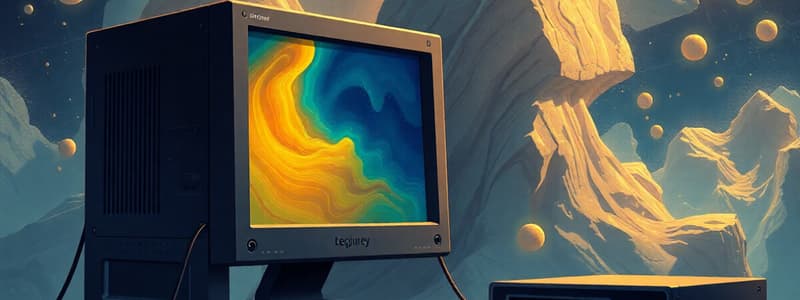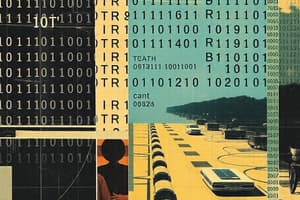Podcast
Questions and Answers
What is the primary role of networks in computing systems?
What is the primary role of networks in computing systems?
- To connect computers for sharing resources and enabling communication. (correct)
- To enhance the processing speed of individual computers.
- To replace the need for software applications.
- To improve the aesthetics of hardware design.
Which of the following describes a characteristic of early computers?
Which of the following describes a characteristic of early computers?
- They were large, complex, and rapidly advancing in technology. (correct)
- They were portable and designed for personal use.
- They were primarily designed for artificial intelligence tasks.
- They utilized cloud computing from their inception.
What ethical consideration is paramount regarding computing systems?
What ethical consideration is paramount regarding computing systems?
- Addressing algorithmic bias and privacy concerns. (correct)
- Increasing the number of installations per year.
- Maximizing profits from technology sales.
- Ensuring user interfaces are visually appealing.
Which advancement is expected to significantly impact the future of computing?
Which advancement is expected to significantly impact the future of computing?
How do peripherals contribute to computer systems?
How do peripherals contribute to computer systems?
What is the primary function of a CPU in a computer?
What is the primary function of a CPU in a computer?
Which of the following represents the correct sequence of core functions of a computer?
Which of the following represents the correct sequence of core functions of a computer?
Which type of computer is typically used for complex scientific simulations?
Which type of computer is typically used for complex scientific simulations?
What distinguishes high-level programming languages from lower-level ones?
What distinguishes high-level programming languages from lower-level ones?
What are embedded systems primarily used for?
What are embedded systems primarily used for?
Which of the following components serves as temporary storage for data and instructions being currently used?
Which of the following components serves as temporary storage for data and instructions being currently used?
Which of the following best describes the function of software?
Which of the following best describes the function of software?
Which encoding system is commonly used for representing text data in computers?
Which encoding system is commonly used for representing text data in computers?
Flashcards
The Internet
The Internet
A network connecting computers worldwide, allowing access to information and communication.
Peripherals
Peripherals
Physical devices that extend a computer's capabilities, such as printers and scanners.
History of Computing
History of Computing
Early computers were large and complex, but have rapidly evolved with each generation.
Ethical Computing
Ethical Computing
Signup and view all the flashcards
The Future of Computing
The Future of Computing
Signup and view all the flashcards
What is a computer?
What is a computer?
Signup and view all the flashcards
Input
Input
Signup and view all the flashcards
Processing
Processing
Signup and view all the flashcards
Storage
Storage
Signup and view all the flashcards
Output
Output
Signup and view all the flashcards
CPU
CPU
Signup and view all the flashcards
RAM
RAM
Signup and view all the flashcards
Programming Languages
Programming Languages
Signup and view all the flashcards
Study Notes
Definition of a Computer
- A computer is a programmable electronic device that can store, retrieve, and process data.
- It executes tasks based on instructions given in a language it understands.
- Key components include input devices (keyboard, mouse), processing units (CPU), memory (RAM), and output devices (monitor, printer).
Core Functions of a Computer
- Input: Acquiring data from the external world.
- Processing: Manipulating and transforming data according to instructions.
- Storage: Saving data for later use and retrieval.
- Output: Presenting processed data in a usable format for the user.
Types of Computers
- Personal Computers (PCs): Designed for individual use, ranging from desktops to laptops.
- Workstations: Powerful computers for specific professional tasks.
- Mainframes: Large, high-capacity computers used by large organizations for vast amounts of data processing.
- Supercomputers: Extremely powerful computers, often used for simulations and data analysis.
- Embedded Systems: Computers integrated into other devices like cars, appliances, and industrial machines.
- Mobile Devices: Smartphones, tablets, and handheld devices with computer capabilities.
Computer Architecture
- Central Processing Unit (CPU): The computer's "brain," executing instructions.
- Memory (RAM): Temporary storage for data and instructions used by the CPU.
- Storage Devices: (e.g., hard drives, SSDs) Permanent data storage.
- Input/Output (I/O) Devices: Facilitate communication between the computer and external devices or the user.
Programming Languages
- Sets of instructions to control a computer's actions.
- Examples include Python, Java, C++, and many others.
- High-level languages resemble human language; low-level languages resemble machine code.
Software
- Provides instructions for the computer to execute.
- Operating Systems (OS): control hardware and software execution.
- Applications enable specific tasks like word processing or internet browsing.
Data Representation
- Data is represented as binary code (0s and 1s).
- Different data types (numbers, text, images) use specific encoding methods.
- Systems like ASCII and Unicode specify how data is encoded.
Computing Systems
- Computer systems encompass peripherals like printers and scanners, extending functionality.
- Networks allow computers to share resources and data, enabling communication and collaboration.
- The internet is a large interconnected network for worldwide communication and information.
History of Computing
- Early computers were large and complex.
- Development rapidly improved across generations.
- Miniaturization and increased computing power are key focuses.
- Examples of early computers include ENIAC and Colossus.
Ethical Considerations
- Computing's impact on society, privacy concerns, and algorithmic bias must be considered.
- Responsible AI development and deployment are crucial.
- Privacy and security are essential in computer systems.
Future of Computing
- Advancements in AI, cloud computing, and quantum computing.
- Increased connectivity and data processing capabilities are expected.
- Efficiency, sustainability, user experience, and ethics will be important considerations.
Studying That Suits You
Use AI to generate personalized quizzes and flashcards to suit your learning preferences.




